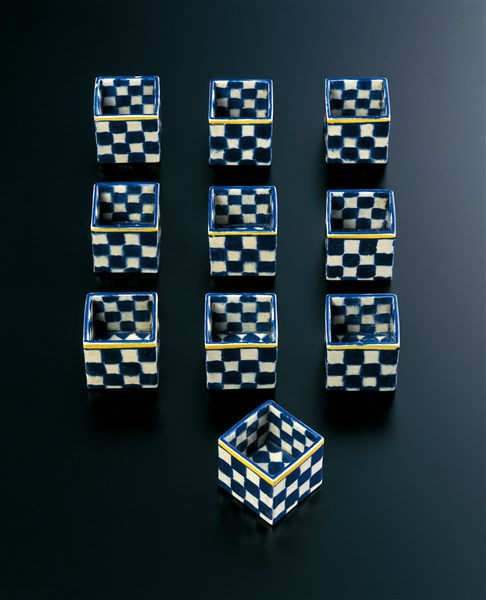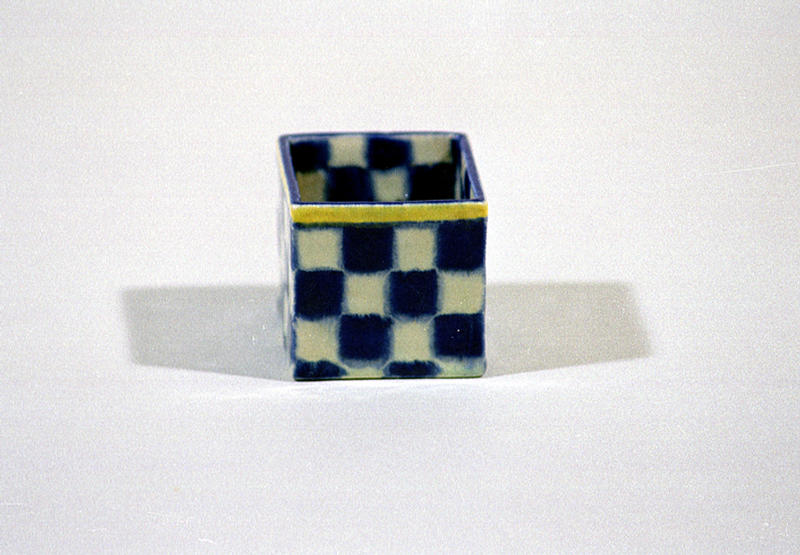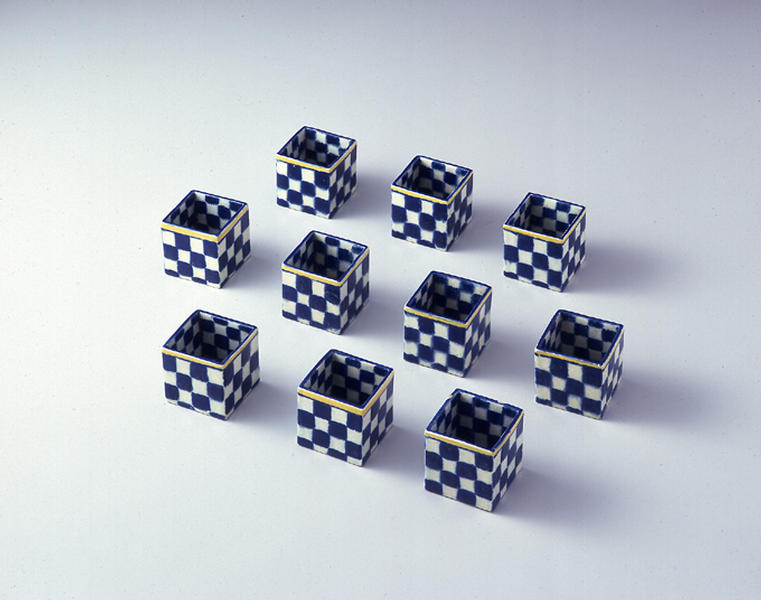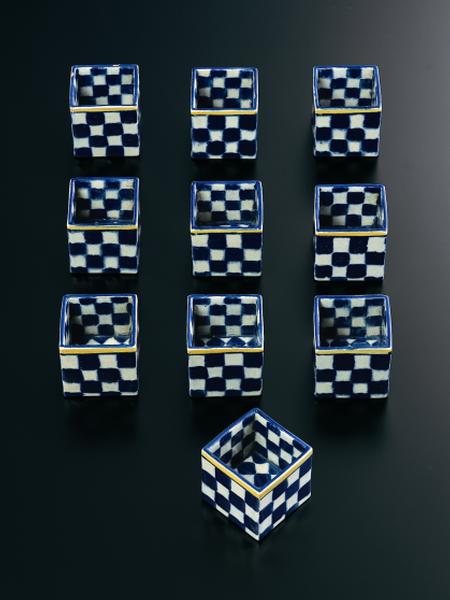乾山色絵阿蘭陀写市松文猪口
- 京都
- 江戸時代
- 18-19c
- 乾山陶製、色絵
- H-4.5 D-5 W-4.5
尾形乾山
尾形乾山(おがたけんざん 1663~1743)
乾山は、寛文3年(1663)京都の富裕な呉服商尾形宗謙(おがたそうけん)の三男として生まれました。兄は画家の光琳です。二人の性格は対象的で、光琳が派手好みであったのに対し乾山は内省的、隠遁的な性格の持主であったといわれています。
野々村仁清に陶芸を学んだ乾山は、元禄12年(1699)37歳のとき京都市の鳴滝に開窯しました。そして正徳2年(1712)50歳の乾山は、京市内の二条丁子屋町に移住し、多くの作品を手がけ「乾山焼」として世にもてはやされました。鳴滝時代の末期からこの丁子屋町時代にかけて兄の光琳は絵付で乾山を助け、兄弟合作の作品が数多く残されています。
享保16年(1731)69歳の頃に江戸に下り寛永寺(かんえいじ)領入谷(いりや)に窯を築いて晩年を送りました。そして81歳で没するまで江戸に在住し陶器や絵画の制作に手腕を発揮しました。
乾山の作品は陶芸作品のみならず書や絵画においても、俗気を脱したおおらかで文人的な洒脱味があります。陶芸作品においては成形、施釉、焼成は他の専門的な陶工に任せたり、絵付についても光琳との合作以外に複数の専門画家が携わっていたと思われるなど、基本的には工房生産という態勢をとっていたようです。しかし、乾山の指導のもとにつくられたやきものには、その大胆なデザイン感覚とともに乾山特有の芸術性が溢れ、乾山その人とふれあうような親しみが感じられるのです。
乾山銹絵染付掻落絵替汁次
乾山銹絵染付梅波文蓋物
乾山立鶴図黒茶碗
乾山銹絵染付桔梗図筒向付
乾山銹絵染付草文四方鉢
乾山銹絵染付松図茶碗
乾山色絵短冊皿
乾山銹絵絵替長平皿
乾山色絵寿字輪花向付
乾山銹絵絵替四方皿
乾山銹絵染付絵替筒向付
乾山銹絵染付松図茶碗
乾山色絵椿文向付
乾山銹絵染付春草図茶碗
乾山銹絵染付藤図向付
乾山色絵立葵図向付
乾山色絵雪杉図向付
乾山色絵桔梗文盃台
乾山銹絵馬図香合
乾山銹絵染付絵替扇形向付
乾山銹絵掻落雲唐草文大鉢
乾山銹絵草花波文水指
乾山銹絵染付絵替土器皿
乾山色絵槍梅図茶碗
乾山黒楽梅図茶碗
乾山銹絵染付芙蓉図茶碗
銹絵掻落牡丹唐草文香合
撫子図(尾形乾山筆)
乾山色絵和歌陶板
乾山色絵竜田川図向付
乾山銹絵牡丹画角皿 尾形光琳画
乾山銹絵百合形向付
乾山銹絵松文香合
乾山色絵薄図蓋茶碗
乾山銹絵菊図水指
鶴亀図黒茶碗
紅葉図 尾形乾山筆
三十六歌仙絵/在原業平像 尾形乾山筆
三十六歌仙絵/斎宮女御像 尾形乾山筆
乾山色絵菊文手付汁次
三十六歌仙絵/小野小町像 尾形乾山筆
乾山銹絵染付山水図茶碗
解説(春の玉手箱)
元禄一二年(一六九九)に京都の西北、鳴滝の地に窯を開いてから一三年後の正徳二年(一七一二)、乾山は洛中の二条丁子屋町に移り住む。いわゆる乾山の二条丁子屋町時代である。二代乾山となる猪八を後継者として養子に迎え、借窯という形で京焼の生産体制に参入、並行して猪八工房を運営し、次第にブランドとしての「乾山焼」の人気を博して名声を確立していった時期でもある。多くの需要に応じるため工房方式で量産、広く一般化したために器種も自然、食膳器が多くなっている。
呉服商を生家にもつ乾山は、自らの素養に感応し、目に触れるさまざまな美術工芸品の意匠や技法を陶芸に活かしている。一六世紀末~一七世紀にかけて大量に流入してきた外国製陶磁器のひとつにオランダのデルフト陶があり、乾山もオランダ写しとして模倣している。この猪口は、白泥と呉須を使って碁盤の目状に交互に塗り分ける、いわゆる市松文の意匠で、見込は碁盤目を四五度傾けて変化を持たせている。底部には「乾山」銘と「爾」の花押が記されている。細部にまで神経を使って丁寧に仕上げられ、口縁際の黄色の縁取とデルフト・ブルーと呼ばれる青色が目に鮮やかな作品である。
Catalogue Entry
Kenzan established a kiln in the Narutaki region in Kyoto's northwest in 1699 and then in 1712, moved his kiln into the center of town, in the Nijo Chojiyacho district. This period has hence been dubbed Kenzan's Nijo Chojiyacho period. During this period Kenzan welcomed Ihachi as his successor, since dubbed Kenzan II, and they ran the Ihachi workshop as a companion kiln to that of Kenzan, collaborating and using Kyoyaki production methods. This period witnessed the growing popularity of the Kenzan ware “brand" and established Kenzan's fame. The workshop system allowed for the mass production of works to fill the large numbers of orders received, and the general nature of these requests led to a focus on food and serving bowls.
Kenzan was born the son of a kimono merchant and he used his own training and understanding of the many ideas and techniques he had experienced in various arts and decorative arts and applied them to his creation of ceramics. Delft ware from Holland was one of the many kinds of foreign ceramics which were imported into Japan in huge numbers from the end of the 16th century through 17th century, and here Kenzan has tried his hand at imitating Delft ware styles. White slip and cobalt blue have been applied in a checkerboard pattern called the Ichimatsu pattern in Japan. The interior of the bowl has been transformed, with the checkerboard pattern set at a 45 degree angle. The base of the cups are signed “Kenzan" and marked with the written seal “Ji". The careful formation and attention to detail found in these exquisite works can be seen in the fresh tones of the yellow rim and bright “Delft blue."



